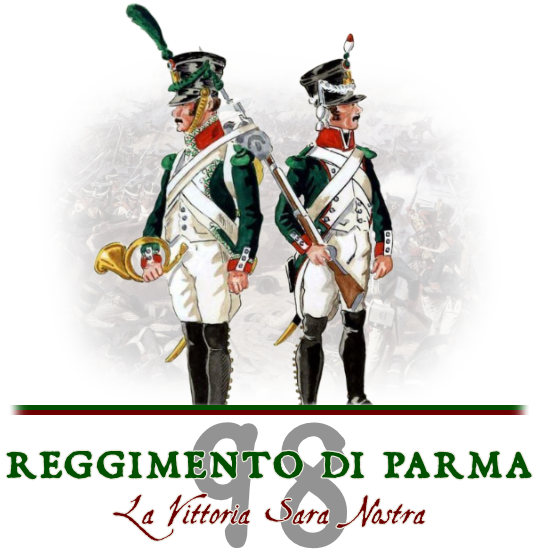1
Regiments (Game Clans) / 98° Reggimento di Parma [TR/EU]
« on: February 14, 2022, 10:18:23 pm »
* * *
About Us
The 98e firstly formed as a strong Turkish community is now also opening to eu players which has been established on the 8th of June 2020. We are always looking for new members.
We are a relaxed group of friends just trying to have as much fun as possible whilst still trying our best and showing a mild form of discipline to keep
everything well organised in the events we partake in. Everyone is welcome to join, old and new players alike.
We are a relaxed group of friends just trying to have as much fun as possible whilst still trying our best and showing a mild form of discipline to keep
everything well organised in the events we partake in. Everyone is welcome to join, old and new players alike.
Ranks Commissioned Officers Colonnello Tenente Colonnello Maggiore Capitano Tenente Sottotenente Non-Commissioned Officers Aspirante Sergente Maggiore Sergente Caporale Maggiore Caporale Enlisted Veterano Grenatiere Fuciliere Soldato Regolore Soldato Di Prima Soldato Recluta Voluntario | History of Italy during the Napoleonic Wars Soon after Napoleon claimed the title of emperor in 1804, the Italian Republic became a kingdom, proclaimed on March 17, 1805. Napoleon, as king of Italy, appointed his stepson, Eugène de Beauharnais, as viceroy and Antonio Aldini as secretary of state, forcing Melzi to step aside. Although Italian autonomy remained limited, Napoleon’s victories, which constantly increased the territory of the kingdom, provided some compensation. Venetia was annexed to it by the Treaty of Pressburg (December 26, 1805), and Dalmatia and Istria were attached to the kingdom with a separate constitution. In a reorganization following the Treaty of Schönbrunn (October 14, 1809), Dalmatia and Istria were joined with Trieste and Ragusa (now Dubrovnik, Croatia), together with other territories ceded by Austria, to form the seven French départements of the Illyrian provinces. The Marche became part of the Italian kingdom in April 1808. Liguria was directly annexed to France on June 4, 1805, as was Tuscany in March 1808. In 1809 Napoleon abolished the temporal power of the papacy and annexed Rome and the remainder of the Papal States to France. Pope Pius VII responded by excommunicating Napoleon, who in response held the pontiff prisoner, first in France and later in the Ligurian town of Savona. As emperor of France and king of Italy, Napoleon directly controlled all of northern and central Italy. During his rule, far-reaching reforms were instituted. Although the new Italian legal codes were translated almost verbatim from the French with little regard for Italian traditions, they introduced a modern jurisprudence responsive to the rights of the individual citizen. Properties held in mortmain, the old feudal ecclesiastical tenure (specifically those of the regular clergy), were transferred to the state and sold. The remaining feudal rights and jurisdictions were abolished. Roads were improved everywhere, and both primary and higher education were strengthened. In return for higher taxes, Italians thus gained a network of new and improved services that were to hasten Italian social and economic progress and cohesion. In the south, after the repression and executions of 1799, the Bourbons experimented with some cautious reforms, mainly fiscal and antifeudal. These were implemented to strengthen the loyalty of the rural population, which had already proved so valuable to the monarchy. But the Neapolitan government was desperately weak, both politically and militarily. Indeed, the French reoccupied the country between February and March 1806, and the Bourbon court once more fled to Sicily. On March 30, 1806, Napoleon’s brother, Joseph Bonaparte, was proclaimed king of Naples. When he became king of Spain in 1808, he was replaced by one of the most famous French generals, Joachim Murat. Despite this change, the nine years of French rule in southern Italy were a period of continuity, and, consequently, French reforms had a lasting impact. Joachim Murat was more independent of Paris than Joseph Bonaparte had been. During his reign there were fewer French ministers and advisers in proportion to Neapolitan officials, and he opposed the enforcement of the Continental System. Feudal privileges and immunities were finally abolished, although the landed aristocracy retained extensive power in the countryside. By purchasing the property confiscated from the church and from exiled landowners, southern notables subverted Murat’s plan to distribute small landholdings to peasant families. Much common land, originally usurped by large landowners, was recovered, but this worked to the benefit of bourgeois notables known in the south as galantuomini (“honourable men”). Fiscal, judicial, and educational reforms, similar to those introduced in the Kingdom of Italy, were implemented in Naples.  |
  |

No.1 La Compagnia Rosso
Company managed by Cpt. Luz1kA. It is the main company of the regiment. It is the most crowded division of the regiment, to serve in this division until its members reach the Soldato rank.
They can choose a company or continue from that company after passing the Soldato rank.
Rosso [95+] • CO's: 2 • NCO's: 3 • Enlisted: 50 • Recruits: 15+
They can choose a company or continue from that company after passing the Soldato rank.
Rosso [95+] • CO's: 2 • NCO's: 3 • Enlisted: 50 • Recruits: 15+

No.2 la Compagnia Verde
It is the most important division of 98e Reggimento di Parma. Company managed by Col. Giles. This company is now a certain level in the game. They represent the 98e Regiment in important matches and tournaments.
Doing the important job of this company in wars and events, Recruiting with the elimination system and always actively setting up company-specific LB or GF information.
Verde [20] • CO's: 1 • NCO's: 1 • Enlisted: 16 • Recruits: 0

No.3 La Compagnia Artigliere
It is the divison of the 98e Reggimento di Parma's artillerymen led by Cpl. Mano. They have the capability of obliterating an enemy line with a single shot. They conatin the most experienced players of Turkiye.
Every Saturday they represent 98e Reggimento di Parma at various events.
Artiglere [6] • CO's: 0 • NCO's: 1 • Enlisted: 5 • Recruits: 0
No.4 La Compagnia Cavalleria
PASSIVE














